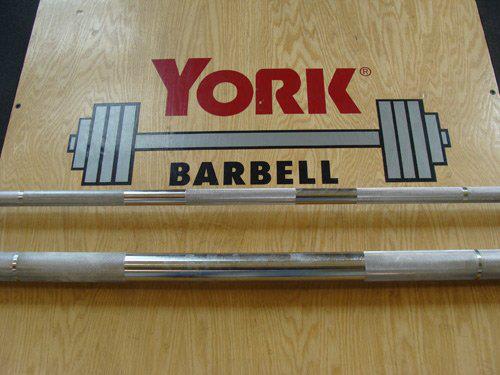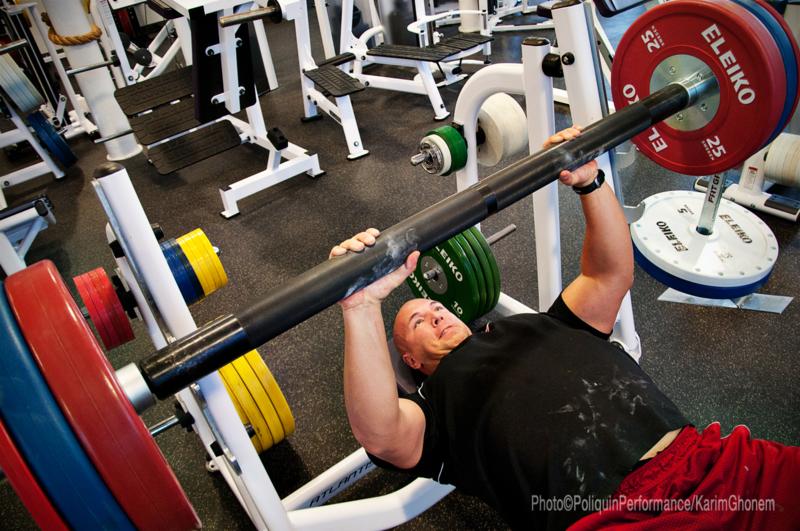In the last few years there has been a lot of talk about the advantage of thick bar barbells and dumbbells compared to standard barbells and dumbbells.
Thick barbells are, well, barbells that are thicker (more accurately, larger diameters).
A thin barbell is 1” (2.54 cm) to 1 1/16” (2.70 cm) thick (diameter). Meanwhile a thick (or fat) barbell has a diameter of usually 2” (5.25 cm), but can go up to 3”.

Thick bars are supposed to increase muscle activation and help improve strength gains.
Imagine the difference between grabbing a golf ball and grabbing a softball, and you’ll get the idea. It’s harder to hang on tight to that softball.
In theory, because it’s harder to hang on to a thick bar, you should get more muscles working to help. More muscles working means bigger and stronger, right?
Sounds good! Where do I sign up?
Research question
Actually, I’ve tried thick bars and they do make certain exercises a lot harder. It definitely feels different – chin ups are definitely harder — but I can’t say whether I had more muscle activation, nor did I use them long enough to say thick bars lead to better strength gains.
In this week’s review I look at a study that explores whether bar diameter changes neuromuscular activation and maximum voluntary contraction.
Fioranelli D, Lee CM. The influence of bar diameter on neuromuscular strength and activation: inferences from an isometric unilateral bench press. J Strength Cond Res. 2008 May;22(3):661-6.
To make things more interesting I challenge you to find the fault in this study’s design. Hint: you might be able to figure it out from the title.
Methods
The study was a repeated-measures design.
This means that the study had the participants do the same exercise twice. The participants used the thin (normal) bar once and they used the thick (fat) bar once, and then the two were compared.
In this study the exercise was a bench press, but with a twist or two:
a) it was unilateral (one arm) and
b) it was isometric (static or no movement).
But there’s a bit more: the researchers did the isometric contractions at two angles – one at the bottom of a normal bench press (45 degrees at the elbow joint) and one at the mid-point of a normal bench press (elbow joint at 90 degrees).
The participants
Who were the lucky bench pressers? No big shocker – they were eighteen college/university age men (no shocker since most exercise studies end up with men that are going to college).
The guys were on average 25 years old, 78.6 kg and 11.2% body-fat. They also had to be free of neuromuscular, cardiovascular and metabolic disease. The most impressive thing was the requirement that they had to have at least 1 year of consistent weight training and be proficient (experienced) in bench pressing.
The procedure
This was a pretty straightforward study. Researchers tested participants on 2 separate days (one for maximum contraction and one for neuromuscular activation) with at least 1 week between test days.
No caffeine was allowed on test days. (Hmmm… must have been hard for university students not to drink coffee or Red Bull for two whole days.)
On one test day, the somewhat sleepy participants were tested for maximum voluntary contraction (MVC).
Researchers strapped the subjects into a fancy smancy Biodex System 3 Dynamometer – a machine that measures force. In a bench press position, participants pushed for all their might for 5 seconds.
One week later, on test day #2, the still-sleepy participants were tested for neuromuscular activation by putting electromyography electrodes (a way of measuring muscle electrical activity) on the pectoralis major (the largest chest muscle that is most involved in bench pressing) and on the forearm flexor region (the muscles you would use to, say, squeeze a tennis ball).
Participants were contracted at 80% of their MVC (from last time) and the neuromuscular activity was measured.
By the way, all tests were done on the dominant arm.
Results
First, I have to say this was the shorts results section I’ve ever seen in any scientific article – one paragraph of five sentences!
What they found was:
- There was no difference in MVC between bars and either joint angle (45 degree and 90 degree elbow joint).
- If you look at both angles there was more neuromuscular activity (as indicated by electromyographic activity) of the pectoralis major in the thin bar compared to the thick bar.
- In both angles the thin bar had more neuromuscular activity in the forearm flexors compared to the thick bar.
Conclusion
While this study didn’t show any advantages to using a thick bar, in fact it showed that using a thin bar may be beneficial; there are studies that have shown differences (1-3).
Another study (3), showed that there was no difference in 1 repetition maximums in pushing exercises (like in this study), but they did find differences in pulling exercises (deadlift and bent-over row).
In pulling exercises, the thicker bar lead to lower 1 rep maxes compared to thinners bars. Not a surprise, since a thicker bar makes gripping the bar more difficult (1 & 2).
So with that info have you figured out the flaw in the study?
If I designed this study I would have used an exercise that would better show differences between thick and thin bars, such as a pulling exercise, where a thicker bar would challenge the grip. Using a pushing exercise doesn’t really challenge the grip and arguably isn’t the best type of exercise to figure out whether bar diameter matters for strength and neuromuscular activation.
Why did they design a study using a pushing exercise?
Well, with a pulling exercise it would be harder to get electromyographic activities – with the bench press the body can be stabilized so that movement wouldn’t cause problems with the readings.
The moral of the story is that studies aren’t flawed because of poor design, but usually because of measurement limitations. In order to get the measurement they want sometimes scientist settle for a less than perfect design or model.
Do you think scientists want to measure genetic differences in mice because of some great interest in mice? Nope, it’s because they can’t do it in the model they want – namely people.
Bottom line
This study shows that using a thick bar isn’t beneficial in terms of neuromuscular activation, at least for pushing exercises done isometrically.
However, I’d say pulling exercises are a completely different animal and in that case a thicker bar could be beneficial – but the jury is still out.
I’d say if you have access or can get access to a thick bar then give a try, and see if you like it.

References
Click here to view the information sources referenced in this article.
Learn more
Want to get in the best shape of your life, and stay that way for good? Check out the following 5-day body transformation courses.
The best part? They're totally free.
To check out the free courses, just click one of the links below.




Share